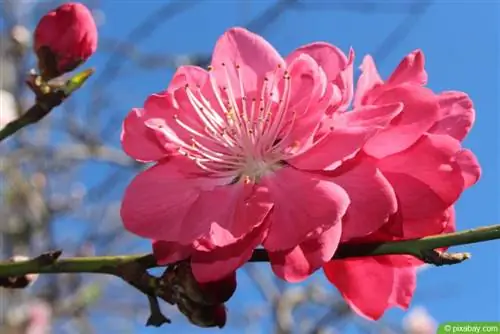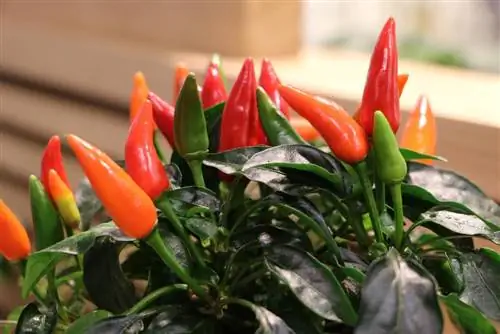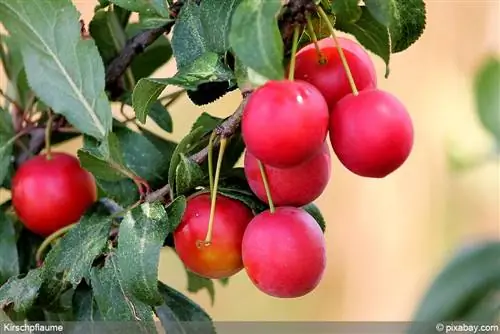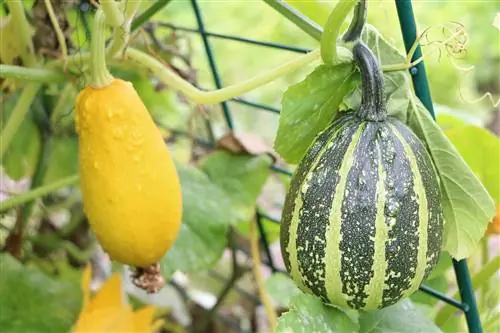- Author admin [email protected].
- Public 2023-12-17 03:39.
- Last modified 2025-06-01 06:48.
Intensely colored flowers, dense, lush growth and even the fruits are decorative - the ornamental quince attracts attention with its beauty - and is extremely easy to care for. Of course, some factors must still be taken into account so that the thorny plant from East Asia can develop in all its glory. With the right knowledge, culture is easily possible even for beginners in garden care. The following instructions show how to do it.
Location
Light-drenched and sunny - this is what the location for the ornamental quince should look like. In its Asian homeland, the false quince also grows in bright places, so that it receives plenty of light as well as a lot of warmth. The south side and places that are at least somewhat protected from cold winds, for example near walls and walls, are ideal.
Substrate
The substrate for the ornamental quince should be nutrient-rich, loamy and deep. High-quality garden soil mixed with mature compost, stable manure and, if necessary, clay powder is ideal. If the garden soil is already loamy, only compost or manure should be added to provide nutrients. It is also recommended to dig up the soil at the planting site and apply fertilizer at least four weeks before planting. This allows the nutrients to spread and settle and be processed by the soil organisms.
Plants
The ornamental quince can be planted either in autumn or spring. So around April or October. Experience has shown that the mock quince does better when planted in October, as it then grows over the winter and can sometimes bloom in the first spring. The soil is prepared as described and then watered to give the roots an incentive to grow deeper. A frost-free and dry day should be chosen to plant the ornamental quince in the garden. The planting distance depends on the intended use. As a solitary plant it should be around two meters. As a hedge, the planting distance should only be one meter. For smaller versions of the ornamental quince, the distance may be even smaller. This should be based on the growth width of the shrub.
Culture in a bucket

Smaller quinces, such as the Japanese ornamental quince, are also wonderfully suitable for cultivation in containers - at least during the first few years or with regular cuttings. However, it is important to ensure that:
- The planter should be as high as possible to give the deep roots enough space
- watering is sufficient and regular, especially if the ornamental quince is covered
- the substrate is chosen to be appropriately nutrient-rich and fertilized or changed regularly
Cultivation in a pot requires a little more effort than in the garden. When selecting the planter, you should also pay attention to how tall and wide the selected ornamental quince species will be. The larger the pot is initially compared to the mock quince, the less care is required and the longer you can wait before repotting for the first time.
Pouring
The ornamental quince tolerates occasional drought well, but it should not last for too long. Watering is therefore carried out as needed after planting when the substrate in the top layers is dry. However, waterlogging should be avoided - especially when growing in a bucket. Good water drainage must therefore be ensured.
If the substrate tends to compact, you can also add a drainage layer of gravel. Coarse gravel or pottery shards at the bottom of the pot are ideal for cultivation in the planter.
Tip:
To prevent drying out, especially at high temperatures and little rainfall, a thick layer of bark mulch can be applied to the substrate. This reduces the casting effort. However, you should then check more often whether the soil still contains enough moisture.
Fertilize
As mentioned, the first nutrient supply should take place when planting. After that, the ornamental quince is frugal. Annual fertilizer applications are usually not necessary. If the growth and flowering power decrease, you can add more mature compost or manure. The fertilizer is applied to the substrate around the shrub and then lightly worked into the soil. In addition, water should be given so that the nutrients are distributed and can penetrate deep into the soil. Experience has shown that when cultivating in containers, fertilization must be carried out a little more frequently. Alternatively, the ornamental quince can be repotted in fresh and nutrient-rich soil.
Blend
The ornamental quince tolerates pruning well and is therefore also ideal as a hedge plant. It can be kept very narrow and makes only a few general demands on the waste. Below:
- clean cutting tool to avoid infections
- Offcut in the morning on a dry day so that the interfaces can dry quickly
- Remove as much as necessary, as little as possible
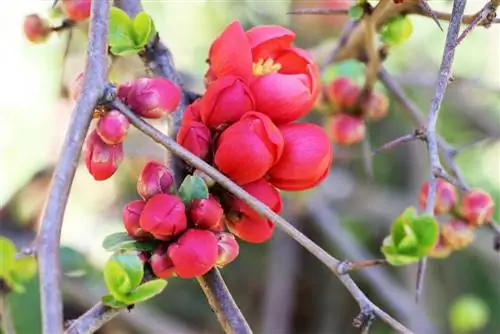
Although the mock quince tolerates trimming well, it does not necessarily need it. In addition, many flowers usually fall victim to this care measure. The main thing to note is that the ornamental quince flowers on two-year-old wood. If you want to preserve the flowering power, thin out the bush only slightly and only remove older, balding branches - but then do so as close to the ground as possible. The ideal time is around March or April, before the first shoots.
Tip:
The ornamental quince tends to go bald quickly, which is why cutting back old shoots to just above the ground has a rejuvenating effect and preserves the flowering power.
Propagation
There are two options for propagating the ornamental quince. On the one hand, the use of seeds. However, this is lengthy and often not successful. Propagation via cuttings is therefore more recommended.
This is done as follows:
- In the spring when the first shoots begin or in June at the latest, shoot tips about 20 centimeters long are cut off.
- The tips should be cut off at an angle if possible so that there is a large cutting surface. If the shoots are well leafed, the lower leaves are removed.
- The shoots are inserted into the soil about five centimeters deep with the cut surface first. Potting soil can be used for this or the same substrate can be used as for the adult ornamental quince.
- Until roots develop, the cuttings are regularly lightly watered to prevent the substrate from drying out.
If you still want to try propagation using seeds instead, remove the pulp from the seeds and store them in a cool place over the winter - for example in the refrigerator. They are then placed on potting soil, lightly covered with substrate and can be placed on a sunny windowsill from March onwards. Kept moist and covered with cling film, they should show the first germs after a few weeks. To avoid mold and mildew, the planter is either placed in a warm, damp place or the foil cover is removed briefly every day and ventilated.
Poisonous or edible?
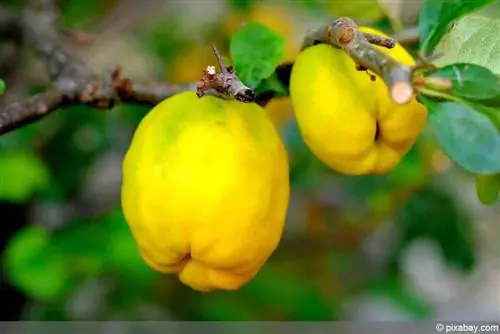
The ornamental quince is a rose plant, but its fruits are called apples - and are actually edible. Pure and raw, however, they prove to be very hard. The juice squeezed from it can be used similarly to lemon juice and the fruit can be used to make jam. Due to their low sugar and high pectin content, they are also ideal for cooking in combination with sweet types of fruit.
Harvest
The fruits of the ornamental quince ripen very slowly. They only slowly become ready for harvest in autumn. Evidence of this is a golden yellow to reddish color and a very aromatic smell. If they are harvested now, before the first frost, they will keep in a cool, dark place for several weeks or even months.
If you like it a little sweeter, wait until the first frost to harvest. Once removed, the ornamental quince fruits should then be processed quickly. They only last for a few days.
Tip:
If some apples remain attached to the quince, birds use them as food.
Conclusion
The ornamental quince is an easy-care shrub that doesn't overwhelm even garden care beginners. Neither fertilization nor cuttings are necessary. The plant can be planted as a single shrub or hedge and provides joy for a long time without requiring much effort.


